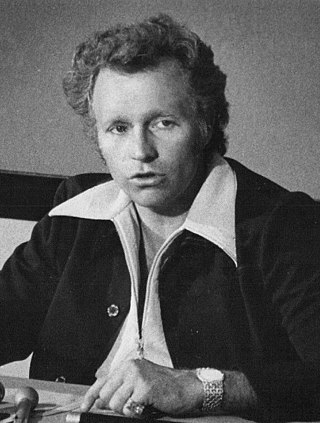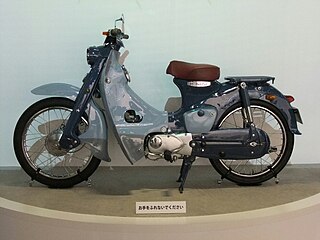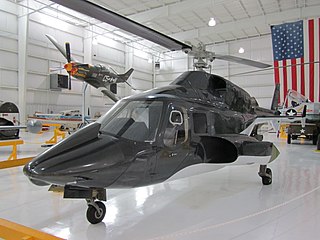
Robert Craig Knievel, known professionally as Evel Knievel, was an American stunt performer and entertainer. Throughout his career, he attempted more than 75 ramp-to-ramp motorcycle jumps. Knievel was inducted into the Motorcycle Hall of Fame in 1999. He died of pulmonary disease in Clearwater, Florida, in 2007, aged 69.

Speed Racer, also known as Mach GoGoGo, is a Japanese manga about automobile racing created by Tatsuo Yoshida. It was originally serialized in print in Shueisha's 1966 Shōnen Book. It was released in tankōbon book form by Sun Wide Comics and later re-released in Japan by Fusosha. Adapted into anime by Tatsunoko Productions, its 52 episodes aired on Fuji TV from April 1967 to March 1968. In the US, the show aired in syndication at approximately the same time. The anime was later re-broadcast on Tokyo MX from July 1 to September 25, 2008.

The Honda Hawk GT (NT650) motorcycle was designated as model RC31 and was designed by Toshiaki Kishi, and was the second Honda with "Pro-Arm" suspension bike after the RC30 VFR750R. The RC model designation is for bikes up to 750 cc, though the Honda Pacific Coast (PC800) has an engine of more than 750 cc and a model designation of RC34.

The CB Series is an extensive line of Honda motorcycles. Most CB models are road-going motorcycles for commuting and cruising. The smaller CB models are also popular for vintage motorcycle racing. The related Honda CBR series are sport bikes.
The Honda XR series is a range of four-stroke off-road motorcycles that were designed in Japan but assembled all over the world.

The Suzuki SV1000 and the half-faired SV1000S are naked bike motorcycles made by Suzuki since 2003. The 996 cc (60.8 cu in) displacement 90° V-twin motorcycles were aimed to compete directly with the Honda VTR1000F, which was released prior to the Suzuki, and the low end Ducati one-litre V-twin engined sport bikes. The SV1000 is the larger version of the popular 650 cc SV650 motorcycle. The SV1000 shares many common parts with the SV650, including all bodywork, but the main frame, handlebars, swingarm and forks are different. The front forks and brakes are sourced from the earlier GSX-R600. The SV1000's engine is sourced from the TL1000S which, inside were over 300 changes to improve low-end and midrange performance.

The Honda Super Cub is a Honda underbone motorcycle with a four-stroke single-cylinder engine ranging in displacement from 49 to 124 cc.

The Honda CB77, or Super Hawk, is a 305 cc (18.6 cu in) straight-twin motorcycle produced from 1961 until 1967. It is remembered today as Honda's first sport bike. It is a landmark model in Honda's advances in Western motorcycle markets of the 1960s, noted for its speed and power as well as its reliability, and is regarded as one of the bikes that set the standard for modern motorcycles.

The Batcycle, Batblade, or Batpod is the fictional personal motorcycle of the DC Comics superhero Batman. In the comic book universe, Batman's personal Batcycle is a modified street-bike with a 786 cc liquid-cooled V-4 engine. It contains a computer-controlled carburetor and bulletproof wind-guard.

The Kawasaki triples were a range of 250 to 750 cc motorcycles made by Kawasaki from 1968 to 1980. The engines were air-cooled, three-cylinder, piston-controlled inlet port two-strokes with two exhaust pipes exiting on the right side of the bike, and one on the left. It was the first production street motorcycle with capacitor discharge ignition (CDI). Right from the first triple model, the 1968 Mach III H1 500 cc, it was a sales success that gained a reputation for almost unmatched acceleration as well as an air of danger for inexperienced riders trying to cope with the bike's increased power to weight ratio over any previously available stock motorcycles.

Airwolf is the helicopter from the 1980s American television series of the same name. Its fictional features included stratospheric ceiling, stealth noise signature, a wide range of weapons and supersonic speed. The Airwolf helicopter was a conventional Bell 222 helicopter modified by attaching some film props.

The Honda Ascot is a name given to two motorcycles produced by Honda in the early 1980s. The motorcycles, the FT500 and VT500FT, were produced with the Ascot name between 1982 and 1984.
A pit bike is a small motorcycle, used primarily for recreational purposes, stunt riding and motocross racing. Pit bikes are characterised by small, air-cooled engines, and are rarely used for professional racing, instead being intended for use in the pit lanes of racing events.

Adrenaline Crew is an American stunt team that started in Los Angeles, California. The team was originally formed to do film stunts but also created their own series of stunt, skit and prank DVDs featuring riders performing various dangerous motorcycle stunt riding and automobile stunts on public roadways.
Knight Rider is an American entertainment franchise created by Glen A. Larson. The core of Knight Rider is its three television series: the original Knight Rider (1982–1986) and sequel series Team Knight Rider (1997–1998) and Knight Rider (2008–2009). The franchise also includes three television films, a short-lived spinoff series, computer and video games, and novels, as well as KnightCon, a Knight Rider convention. Beginning with the original television series and continuing with the subsequent films and series, the franchise has developed a cult following and spawned many pop culture references.

The Honda NC700 series is a family of motorcycles produced by Honda since 2012. NC700 series was a 'new concept', being unlike conventional motorcycles, a bike designed for commuters, new or veteran riders. The series also includes the motorcycle/scooter hybrid NC700D Integra. The NC700 series is classed as a commuter model bike which has incorporated design and mechanical elements from various motorcycle types. The riding position is similar to standard bike styles. There is a helmet-sized internal storage in place of the traditional fuel tank, which in turn is located under the seat. The series is often marketed as fun to ride, easy to handle and very fuel efficient.

The Comstar wheel, sometimes referred to as Com-stars or stylised as ComStar, was a composite motorcycle wheel that Honda fitted to many of its motorcycles from 1977 to the mid 1980s. Its design allowed it the option of being fitted with tubeless tyres and its use on the Honda CX500 was the first time tubeless tyres had been designed for a production motorcycle.















